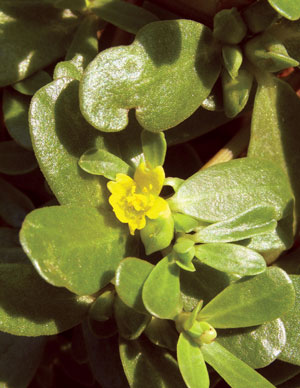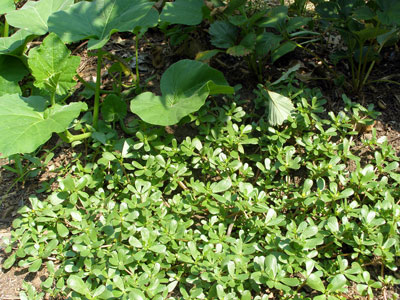By Ken Moore
Flora Columnist
Several years ago, purslane, Portulaca oleracea, began appearing in my vegetable garden. Just last week, I noticed tiny yellow flowers nestled in amongst all the succulent leaves.

To quote from Paul Green’s Plant Book: “A curse in many a garden. This much-branched radiating annual is prolific as crabgrass and as common in all of the dry and sandy soils and waste ground of the Cape Fear Valley. It flowers in July and according to a book I read, like many other plants, it is good for nearly everything under the sun medicinally, being ‘emetic, expectorant, cathartic, diaphoretic, astringent, rubefacient, blistering, stimulant and is used in dropsy and as a powerful external stimulant.’ The Indians used it as a purgative.â€
And from James A. Duke’s Handbook of Edible Weeds: “Only in the United States has fame and favor eluded this hot-weather weed. Tender parts, leaves, flowers, pods, seeds and stems all may be served as potherbs, improved by adding egg and/or breadcrumbs. To me, the herb tastes like a slimy spinach. … The succulent stems may be pickled in brine or pickle vinegar … or to preserve this copious summer food for winter: put it into salt and dry white wine.â€
Alan Weakley, Flora of the Carolinas, Virginia and Georgia, places its origin in Asia, from where it has spread worldwide, with possibly numerous subspecies. I very much appreciate Alan’s assessment of this seemingly unlimited variation: “In North America, these genotypes appear to have intermixed; in our area, the recognition of infraspecific taxa appears to be unwarranted, difficult, and unmeaningful.â€
Now, I like that simplification! Alan goes on to add: “During the great depression, P. oleracea was eaten extensively in the Valley of Virginia as a potherb.â€
So with all these attributes and more, I’m not about to spend time weeding it out of the garden. Last year, it provided a living green mulch beneath my okra. I’m already encouraging it to spread freely beneath squash, pepper and tomato plants for this year’s mulch.
In fact, I can frequently be caught laboriously pulling unwanted plants of any kind when I see them emerging through my carpet of purslane. What I have here is the pursuit of a carpet of purslane as pure and clean as the most perfect weed-free carpet of green lawn pursued by energetic gardeners with similar, but opposed objectives. You are already familiar with that old notion that “one person’s weed is another one’s treasure.â€
This lowly ground cover is a true camel of the field. I am amazed each day as I notice how rapidly single plants can grow from seedlings to cover a foot or two of surface in utter defiance of days and days without water.
And just this past week, to practice what I describe, I enjoyed sautéing purslane with egg, of course with the necessary onions and olive oil, and, in addition, a fresh salad of conventional greens adorned with fresh succulent purslane leaves on the side. Both were delicious. The sautéed purslane was a nutty flavored delicacy, not at all the “slimy spinach†described by Dr. Duke.
Now that I reflect back, I realize that I forgot to add some of that spicy peppergrass growing along the drive.
Email Ken Moore at flora@carrborocitizen.com.
Find previous Ken Moore Citizen columns at The Annotated Flora.


